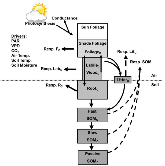Merging a mechanistic enzymatic model of soil heterotrophic respiration into an ecosystem model in two AmeriFlux sites of northeastern USA
- Univ. of Maryland Center for Environmental Science, Frostburg, MD (United States). Appalachian Lab.; Oak Ridge National Lab. (ORNL), Oak Ridge, TN (United States). Climate Change Science Inst., Environmental Sciences Division
- Univ. of Maryland Center for Environmental Science, Frostburg, MD (United States). Appalachian Lab.
- Pacific Northwest National Lab. (PNNL), Richland, WA (United States). Joint Global Change Research Inst.
- Woods Hole Research Center, Falmouth, MA (United States)
- Harvard Univ., Cambridge, MA (United States). Department of Organismic and Evolutionary Biology; Northern Arizona Univ., Flagstaff, AZ (United States). School of Informatics, Computing, and Cyber Systems/Center for Ecosystem Science and Society
- Lawrence Berkeley National Lab. (LBNL), Berkeley, CA (United States)
- USDA Forest Service, Durham, NH (United States). Northern Research Station
Heterotrophic respiration (Rh), microbial processing of soil organic matter to carbon dioxide (CO2), is a major, yet highly uncertain, carbon (C) flux from terrestrial systems to the atmosphere. Temperature sensitivity of Rh is often represented with a simple Q10 function in ecosystem models and earth system models (ESMs), sometimes accompanied by an empirical soil moisture modifier. More explicit representation of the effects of soil moisture, substrate supply, and their interactions with temperature has been proposed as a way to disentangle the confounding factors of apparent temperature sensitivity of Rh and improve the performance of ecosystem models and ESMs. The objective of this work was to insert into an ecosystem model a more mechanistic, but still parsimonious, model of environmental factors controlling Rh and evaluate the model performance in terms of soil and ecosystem respiration. The Dual Arrhenius and Michaelis-Menten (DAMM) model simulates Rh using Michaelis-Menten, Arrhenius, and diffusion functions. Soil moisture affects Rh and its apparent temperature sensitivity in DAMM by regulating the diffusion of oxygen, soluble C substrates, and extracellular enzymes to the enzymatic reaction site. Here, we merged the DAMM soil flux model with a parsimonious ecosystem flux model, FöBAAR (Forest Biomass, Assimilation, Allocation and Respiration). We used high-frequency soil flux data from automated soil chambers and landscape-scale ecosystem fluxes from eddy covariance towers at two AmeriFlux sites (Harvard Forest, MA and Howland Forest, ME) in the northeastern USA to estimate parameters, validate the merged model, and to quantify the uncertainties in a multiple constraints approach. The optimized DAMM-FöBAAR model better captured the seasonal and inter-annual dynamics of soil respiration (Soil R) compared to the FöBAAR-only model for the Harvard Forest, where higher frequency and duration of drying events significantly regulate substrate supply to heterotrophs. However, DAMM-FöBAAR showed improvement over FöBAAR-only at the boreal transition Howland Forest only in unusually dry years. The frequency of synoptic-scale dry periods is lower at Howland, resulting in only brief water limitation of Rh in some years. At both sites, the declining trend of soil R during drying events was captured by the DAMM-FöBAAR model; however, model performance was also contingent on site conditions, climate, and the temporal scale of interest. While the DAMM functions require a few more parameters than a simple Q10 function, we have demonstrated that they can be included in an ecosystem model and reduce the model-data mismatch. Moreover, the mechanistic structure of the soil moisture effects using DAMM functions should be more generalizable than the wide variety of empirical functions that are commonly used, and these DAMM functions could be readily incorporated into other ecosystem models and ESMs.
- Research Organization:
- Oak Ridge National Laboratory (ORNL), Oak Ridge, TN (United States); Pacific Northwest National Laboratory (PNNL), Richland, WA (United States); Lawrence Berkeley National Laboratory (LBNL), Berkeley, CA (United States)
- Sponsoring Organization:
- USDOE Office of Science (SC), Biological and Environmental Research (BER)
- Grant/Contract Number:
- AC05-00OR22725; AC02-05CH11231; SC0006741; 2014-67003-22073; AC05-76RL01830
- OSTI ID:
- 1462870
- Alternate ID(s):
- OSTI ID: 1455296; OSTI ID: 1462972; OSTI ID: 1702579
- Report Number(s):
- PNNL-SA-133991
- Journal Information:
- Agricultural and Forest Meteorology, Vol. 252, Issue C; ISSN 0168-1923
- Publisher:
- ElsevierCopyright Statement
- Country of Publication:
- United States
- Language:
- English
Web of Science
| Constraining carbon and nutrient flows in soil with ecological stoichiometry | text | January 2019 |
| Constraining carbon and nutrient flows in soil with ecological stoichiometry | text | January 2019 |
Simultaneous numerical representation of soil microsite production and consumption of carbon dioxide, methane, and nitrous oxide using probability distribution functions
|
journal | November 2019 |
Response of soil microbial communities to altered precipitation: A global synthesis
|
journal | July 2018 |
California air resources board forest carbon protocol invalidates offsets
|
journal | January 2019 |
Constraining Carbon and Nutrient Flows in Soil With Ecological Stoichiometry
|
journal | October 2019 |
Similar Records
Simultaneous numerical representation of soil microsite production and consumption of carbon dioxide, methane, and nitrous oxide using probability distribution functions
Constrained partitioning of autotrophic and heterotrophic respiration reduces model uncertainties of forest ecosystem carbon fluxes but not stocks














